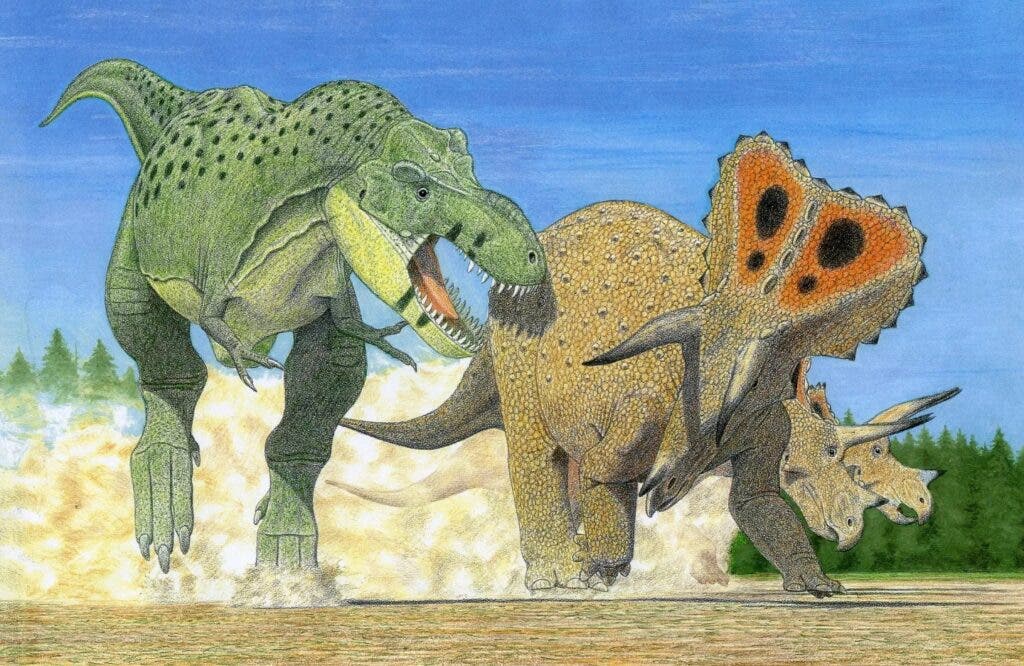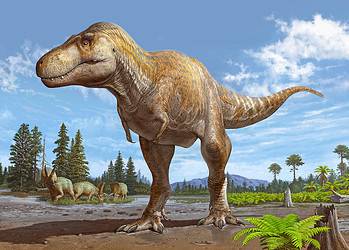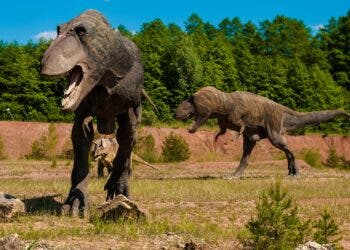
By a wide margin, Tyrannosaurus rex is the most famous and most beloved dinosaur in the world. Named the “king of the tyrant lizards, everything about this ferocious Cretaceous predator looks like it was built to rule, from its muscular body stretching as long as a school bus, snout to tail, to its stuff skull adorned with 60 serrated teeth, each designed to pierce and grip the flesh of gigantic prey. And like a true king, T. rex reigned single-handedly over his domain, being the only species in the genus Tyrannosaurus. Or is it?
A recent analysis of T. rex fossils suggests that the genus may actually comprise three distinct but closely related species of Tyrannosaurus, citing both anatomical and stratigraphic evidence from three dozen specimens unearthed across the world.
The main differences identified in the three proposed distinct species are quite subtle but significant. These include the shape of the femur and tooth configuration.
Sharing the throne
Telling closely related species apart can be very challenging, especially those that have been extinct for over 65 million years. Take, for instance, a group of South American finches known as “capuchino” seedeaters. Many of these birds look very similar, apart from some subtle hints. Male dark-throated seedeaters and marsh seedeaters look exactly the same in terms of shape and size, except for the color of their plumage. The former has a black throat, while the latter has a white throat. Their songs are also different; one species might have trills in different sections of the song, while another might be buzzy.
Yet plumage color or vocalization can’t be preserved, so very closely related species of dinosaurs can be easily mashed together into a single one. Adding to the challenge is individual variation owed to age and sex.
Previously reported variations in femur shape and specimens with either one or two slender incisor teeth on each side of the front jaw suggested the Tyrannosaurus genus is richer than at first glance. Gregory Paul and colleagues picked up from here and compared the robustness of the femur in 24 T. rex specimens. They also measured the diameter of the base of teeth to see if a specimen had one or two slender incisor teeth.
Some specimens had more study femurs — calculated using the length and circumference of the thigh bone — while others had more gracile femurs. The researchers found that the robust femurs were twice more abundant than the gracile variety. If these substantial differences were owed to sex differences, you’d expect a ratio closer to 50/50. Robust femurs were found in T. rex juveniles while some adult dinosaurs had gracile femurs, which also rules out differences owed to age and development stages.
Concerning teeth variation, the scientists found that T. rex specimens with only one incisor tooth were correlated with often having high femur gracility.
And, finally, the researchers also analyzed each specimen’s stratigraphy, the classification of different layers or layering of sedimentary deposits. When a fossil is found in lower layers of sediment, this means it is older than those found in the soil further up. Of the 37 Tyrannosaurus specimens included in this study, 28 were found in the Lancian upper Maastrichtian formations in North America, which are estimated to be from between 67.5 to 66 million years ago.
But only robust Tyrannosaurus femurs were found in the lower layer of sediment, which is conducive to variation of robustness in other theropod species, indicating that only one species of Tyrannosaurus existed during this era. Only one gracile Tyrannosaurus femur was identified in the middle layer with five other gracile femurs in the upper layer, alongside other robust femurs. This suggests that maybe these specimens found in sediment layers further up developed into more distinct specimens than those found in lower levels.
“We found that the changes in Tyrannosaurus femurs are likely not related to the sex or age of the specimen. We propose that the changes in the femur may have evolved over time from a common ancestor who displayed more robust femurs to become more gracile in later species. The differences in femur robustness across layers of sediment may be considered distinct enough that the specimens could potentially be considered separate species.”
The lizard emperor, king, and queen
Besides T. rex, the researchers have nominated two potential new species: Tyrannosaurus imperator (tyrant lizard emperor) and Tyrannosaurus regina (tyrant lizard queen), both aptly christened to preserve the royal nature of the lineage. The first relates to specimens found at lower and middle sediment layers, characterized by more robust femurs and two incisor teeth. The second, T. regina, is related to specimens from upper and possibly middle layers of sediment, having slender femurs and one incisor tooth. Meanwhile, good old T. rex is connected with the upper and possibly middle layer of sediment, with specimens displaying a more robust femur while having only one incisor tooth.
As a caveat, the number of specimens isn’t very large — at least not large enough to make a convincing case of speciation for such subtle morphological differences. After all, the authors themselves cannot rule out the possibility that the differences they’ve highlighted aren’t owed to extreme individual differences. Furthermore, the exact location within the sediment layers is not known for some specimens.
Even so, the mere tangible possibility that T. rex isn’t alone is fascinating and enthralling. Perhaps we’ll learn more about this royal lineage once more evidence surfaces.
The findings appeared in the journal Evolutionary Biology.






